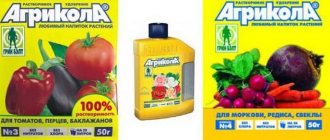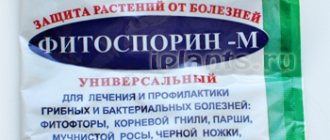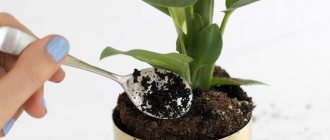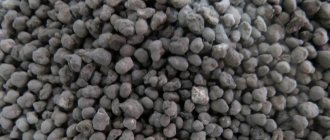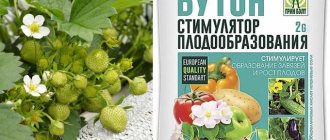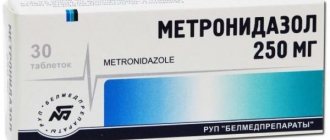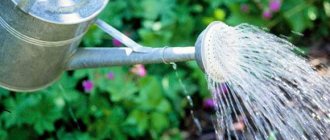Agricola - soluble complex fertilizer
Agricola is a trademark of a series of soluble complex fertilizers from the Russian company.
Agricola fertilizer is available on the market in three main forms; liquid concentrated fertilizers; water-soluble granules (dry powder); fertilizers in the form of sticks. Agricola is widely used for both root and foliar feeding of plants. The elements necessary for plants, which are part of Agricola, do not have to be applied to the soil, like ordinary fertilizers. After spraying with an aqueous solution of this fertilizer, all the necessary nutrients are easily absorbed by the above-ground parts of the plants - leaves and stems, which ensures a quick result of their action on the plant, in contrast to root feeding.
Advantages of Agricola fertilizer:
- High environmental friendliness - “Agricola” does not contain chlorine or heavy metal salts. Fertilizer prevents the entry of nitrates into plants.
- After foliar feeding, plants grow faster, strengthen earlier, and better resist external adverse factors and various diseases.
- The substances contained in Agricola promote better absorption of vitamin C and carotene by plants, which invariably leads to an improvement in the nutritional and taste qualities of fruits, berries, vegetables and fruits.
- Selectivity of action. For each group of plants, its own type of Agricola fertilizer has been created, and each type has its own unique composition, necessary only for this group. For example, cabbage requires more phosphorus, and carrots require more potassium, and seedlings require a lot of nitrogen. To quickly increase green mass.
- The indispensability of using this fertilizer on saline, arid and cold soils. In this case, with the help of Agricola, perhaps the only effective way of feeding plants through stems and leaves is realized.
- Convenient forms for use. Agricola fertilizer is sold in granular form and in bottles as liquid concentrates.
Agricola brand fertilizers are distinguished by their high efficiency, environmental friendliness, and wide range of applications. With their help, you can increase the yield of vegetables and berries, and even improve the quality of the fruit. After using this drug, ornamental flowering plants form more inflorescences and lengthen the flowering period. Widespread distribution is facilitated by convenient forms of release of the drug. You can buy a liquid concentrate, which is diluted 100 or 200 times according to the instructions before use.
Its use makes plants stronger, increases resistance to diseases, and resistance to sudden cold or drought. It increases cell energy, is completely absorbed, and stimulates plant growth. With the help of these drugs you can get high yields and grow a variety of flowers. Liquid and dry Agricola fertilizers, hydrogel and sticks make the work of gardeners rewarded and not in vain. A series of these preparations is a complete nutritional scheme and takes into account the dynamics of plant needs.
Huge flowers! But not sticks, but capricious tablets. Photos in the ground and on land.
Agricola's sticks did not live up to my expectations. I thought that this was a complete replacement for conventional complex fertilizers, or even soil. I put them in a pot and that’s it, beauty! It is much more convenient and faster to mess around with powders or liquid concentrates. No, there is a result, of course, but it’s not exactly what was expected.
I have fertilizer for flowering plants. I focus on this, and why - read on.
The price of Agricola sticks is 90 rubles.
The package contains a blister with large, oval-shaped tablets, 20 pieces.
The sticks break and crumble just when you try to get them out of the cell! But the ease of their use should have been an advantage compared to powder fertilizers.
To push it directly into the ground is a whole epic. You need to make a rather large depression (damaging the roots of the flower! How else?!), carefully place the tablet there and sprinkle with new soil, because compacted material is chronically in short supply.
On the second day of being in the ground, the “long-lasting” fertilizer already turns into a shapeless mass, and on the fifth or seventh day it’s as if it never existed!
The condition of the plants was not affected by either the recommended dosage or the increased one. Healthy plants were still standing, but chlorotic plants continued to show signs of a lack of minerals in every possible way.
Article on the topic: OMU Onion and Garlic BUY - reviews, description
The soil and pots had to be changed with the same frequency. Although it would seem that fertilizers compensate for the small amount of soil and, accordingly, minerals. This means that it would be possible to keep the plants in a small container. Yeah, that's not true.
But the speed of flowering and the size of the flowers impressed me! Such huge flowers are just right to see in the south, but not in our region. Therefore, I recommend Agricola fertilizer, but not as a complex fertilizer, as the manufacturer suggests, but solely to improve flowering; the sticks coped with this with an A plus. And decorative deciduous plants have no use at all.
Compound
In terms of percentage of elements, the composition of Agricola looks like this:
- potassium - 25%;
- phosphorus - 21%;
- nitrogen - 15%;
- trace elements: copper, manganese, boron, molybdenum, zinc, iron.
The complex is formulated with an ideal balance of nitrogen-phosphorus ingredients and potassium.
Agricola mixtures are conventionally divided into two groups:
- for flowering plants
- and for gardeners.
The first group ensures the full potential of flowering, while the second group provides balanced nutritional mixtures for growing plants.
The fertilizer was developed taking into account world experience in creating water-soluble preparations and fully covers the needs of plants during the growing season, providing complete nutrition to both vegetable and flower crops.
Release form
The product is available in various forms:
- liquid concentrate,
- dry granular form,
- sticks.
liquid fertilizer is sold in an economical and convenient form - these are bottles with measuring caps. The content of humic substances is 0.8%. These dietary supplements increase cell energy, mobilize plant immunity and increase the absorption of other useful elements.
By purchasing a 250 ml bottle of liquid form, you get about 45 liters of ready-to-use drug. It's profitable.
The dry form is produced in the form of granules. From a small amount of substrate you get a lot of working solution for applying along the leaf and under the root - this is convenient. Highly concentrated granules contain a full range of microelements and vitamins.
The consumption rate is economical - only 2-2.5 g per 1 liter of water. The product sachets contain from 20 to 50 g, this is enough to obtain several buckets of solution.
The sticks are a unique design, characterized by long-lasting action and ease of use. Perfectly solves the problems of forgetful and inexperienced gardeners. In this form, fertilizers are produced using nutrients that slowly dissolve in water.
This method avoids the risk of overdose or, conversely, lack of nutrients for several weeks after use. The manufacturer puts 20 sticks into the package - this is enough to fully feed 10 plants.
Description and properties of the drug
The need to use fertilizer mixtures is a necessary measure for a number of reasons. And the first is regular exposure to external factors on the soil. Such as deterioration of natural conditions, constant use of land for planting.
In second place is the improper use of the proposed means to protect plants from pests and to improve crop performance. M Agricola is an environmentally friendly product. Plus, it is a mineral fertilizer and is suitable for frequent use.
With the help of fertilizer:
- increase in yield up to 25-30%;
- improving the condition of young plants and seedlings;
- restoration and stabilization of micro and trace elements that the culture needs at certain stages of development.
It is worth adding that the components of the composition are equally suitable for garden and balcony plants, vegetables and berry crops. It is recommended to use to improve vegetative stages: flowering, growth.
A wide spectrum of action is possible due to the balanced composition:
- protection for indoor flowers and fruit and berry bushes from harmful insects;
- strengthening the performance of the immune system;
- increasing resistance to infections and diseases of the immune system;
- formation of more inflorescences. Long flowering;
- brightness of color, improvement of appearance, taste.
Fertilizer is sold in the following forms:
Need to know! Agricola complex fertilizer mixtures are conventionally divided into groups: for flowering and garden crops. The first category is intended to unlock the potential of luxuriantly blooming flowers. The second is balanced nutritional mixtures.
Varieties
- Agricola -1 (for cabbage) – suitable for all types. The seedlings are fertilized for the first time within two weeks after planting (25 grams of dry powder per 10 liters of water). Next, the cabbage needs to be watered with Agricola solution every 2 weeks, 50 grams of fertilizer in 5 liters of water.
- Agricola-2 (for onions and garlic) - the proportion of nitrogen, phosphorus and potassium is 11:11:27%. You can introduce agricola into the soil before planting onions and garlic. It is necessary to dilute 25 grams of fertilizer in 10 liters of water and pour it in the furrows between the beds with garlic and onions. You can also spray the green parts of plants, but then you need to take 12-13 grams of fertilizer for the same amount of water.
- Agricola-3 (for tomato, pepper and eggplant) - acts very quickly, seedlings come to life in a few days, more fruits appear. Composition: 13% N, 20% P and 20% K + trace elements.
- Agricola - 4 for carrots, beets and radishes - 11% nitrogen, 14% phosphorus and 26% potassium; Available in the form of a dry powder, the whole sachet (50 grams), per 20 liters of water.
- Agricola -5 for cucumber, zucchini and melon: 13% nitrogen, 20% phosphorus and 20% potassium. Designed for root and foliar feeding. The first root feeding should be done 2 weeks after planting the seedlings at the rate of 25 grams of fertilizer granules per 10 liters of water. Further feeding should be done every 10-14 days. Foliar feeding is also done - the first time after 2 weeks, then every 10-14 days. It is advisable to spray in the morning or evening.
- Agricola 6 for seedlings of vegetables and flowers. The root system of plants is improved, and the resistance of seedlings to cold and disease improves. 20% sodium, 13% phosphorus and 13% potassium.
- Agricola for berry crops - composed of 15% nitrogen, 17% phosphorus and 28% potassium, 0.5% magnesium + trace elements - boron, copper, zinc, manganese, iron, molybdenum.
- Aqua Agricola for indoor orchids is sold in 250 ml bottles, in the form of a ready-made solution. The ratio of nitrogen, phosphorus and potassium: 4:5:6. The bottle comes with a special measuring cup to measure out the required amount of fertilizer. Fertilizer must be measured strictly according to the instructions; too much fertilizer is dangerous. The instructions say that 5 ml of liquid concentrate must be diluted with a liter of water and watered every 10-14 days.
- Agricola for ficuses - the ratio of the main macroelements is 23% nitrogen, 10% phosphorus and 16% potassium + the trace element magnesium. Provides ficus plants with nutrition and has a positive effect on their growth and development; According to the instructions, 2.5 grams of fertilizer must be diluted in 2 liters of water and water the ficus plants with this solution every 10-14 days.
- Agricola for indoor plants. Available in the form of a liquid concentrate (Aqua Agricola), for irrigation, dilute 10 ml of solution per liter of water. Watering is carried out once a week; to feed the leaves, a solution is prepared in a different concentration - 5 ml per liter of water. Spraying of leaves is carried out once every two weeks.
- Agricola forward for seedlings of vegetables and flowers - intended for very young plants. Dilute 10 ml of fertilizer solution per liter of water. Fertilizer must be applied to damp soil! The composition includes macroelements: nitrogen 1.8%, phosphorus 0.8%, potassium 1%. The fertilizer contains minerals and humates (not less than 0.2%). Root feeding should be carried out at intervals of 7-10 days.
- Agricola for flowering plants: nitrogen (15%), phosphorus (21%), potassium (25%), as well as minerals important for flowers. This fertilizer is used for begonias, geraniums, daisies and other garden flowers.
- Agricola for cacti and succulents - available in the form of a dry powder or ready-made solution. Contains 12 percent sodium, 26 percent phosphorus and 20 percent potassium. Cacti will grow much faster!
Release forms
Agricola fertilizer is available in several different forms. It contains elements necessary for the growth and development of the plant:
- Nitrogen in the amount of 15%.
- Phosphorus - 21%.
- Potassium - 25%.
Other elements (manganese, copper, iron, zinc, etc.) may be contained in smaller quantities. The exact composition of each drug, indicated by a serial number, depends on its purpose.
The liquid product is a concentrate, which is produced in a container equipped with a measuring bottle. This fertilizer is diluted with clean water in a ratio of 1:100 or 1:200.
The dry preparation is available in the form of granules . They can be poured into the soil in their original form or dissolved in water. This variety is available in different packaging - 50-100 grams and 1-1.5 kg. A small bag is enough to fertilize a houseplant, and a large bag can be used to feed vegetables in the garden.
Another form of fertilizer is in the form of sticks. With their help you can feed a small number of plants. To do this, just stick one stick near the bush, and it will gradually dissolve and nourish the plant. This release form has a prolonged action. The cost of packaging such sticks corresponds to the cost of 500 grams of dry granules.
Agricola vegeta is a fertilizer that is widely used to increase leaf mass and improve fruiting of vegetable and berry crops.
of the drug Agricola for yellowing of leaves is also produced . Reviews of the drug Agricola Aquo indicate its high effectiveness in caring for coniferous plants.
Methods of application
- To feed gooseberries and currants, fertilizer is scattered under these bushes in the spring at the rate of 30-40 g per 1 m2. Immediately after this, the soil is loosened to a depth of 7 to 10 cm.
- To fertilize strawberries and raspberries, “Agricola universal” is applied to the ridges, using 6-12 g per 1 m2, after which the surface layer is loosened.
- During the spring preparation of a site for planting vegetable and flower crops, fertilizer is evenly scattered over the surface of the ground in an amount of 30-60 g per 1 m2 on cultivated soils and 60-85 g on uncultivated soils. Afterwards they dig.
- When sowing seeds on moderately fertile soils, an additional 10-15% of the specified norms is added to the ridges.
Fertilizer consumption and the frequency of its application for a specific crop are presented in the table:
| Culture | Dose of the drug | Time, application features |
| All cultures | 30-60 g/m2 – on cultivated soils, 60-85 g/m2 on poorly cultivated soils | Application during soil cultivation in spring or autumn |
| Vegetables, flower and ornamental crops (seedlings), potatoes, strawberries | 0.5-1 g/plant | Application at planting |
| Vegetable, flower and ornamental crops | 2-3 g/linear. m row | Application at planting |
| Vegetables | 10-20 g/m2 | Feeding 2 weeks after emergence or planting of seedlings 1-4 times with an interval of 10-15 days. Last feeding no later than 2 weeks before harvest |
| Flower and ornamental crops | 10-20 g/m2 | Top dressing 2 weeks after emergence or planting of seedlings 2-4 times with an interval of 10-15 days. |
| Fruit and ornamental trees | 40-50 g/m2 trunk circle | Feeding 2-3 times during the season |
| Berry ornamental shrubs | 30-40 g/m2 | |
| Strawberries | 6-12 g/m2 | Fertilizing in early spring and after harvest |
Useful properties of Agricola
When used correctly, the soil is saturated with the beneficial substances described above. According to the results, garden and vegetable plantations produce lush flowering ahead of schedule, the fruits are bright, juicy, aromatic, and quite large.
They tolerate temperature changes, drought, and wintering well. Consumers say that: “Thanks to Agricola, we began to receive better quality vegetables and fruits.”
Absorbed at the cellular level, enhances growth, does not harm human health or the environment. They do not accumulate harmful, toxic substances from the soil. People only benefit, health.
The brightness of flowering plants
This is a complex of useful micro and macro elements. Promotes the growth of garden and garden plants. Universal nutrition for all fruits and flowers.
Additives included:
- nitrogen-containing;
- phosphorus-containing;
- high percentage of potassium.
Each element saturates the plant with useful minerals, promotes growth, flowering, and increases productivity. Due to its high content of bioadditives, Agricola has good customer reviews.
Additional elements enhance the positive dynamics. These include concentrates:
- boron;
- copper;
- manganese;
- molybdenum;
- gland.
Reviews indicate a positive assessment of quality.
“I was truly surprised by the abundance of blooms. After fertilization, the level of productivity pleasantly surprises,” says experienced summer resident Lidiya Fedorovna
Enhances the color of fruit trees, gives better results, bright flowering.
Organic fertilizers
For the most part, mineral supplements are used as fertilizers, consisting of a number of chemical elements combined into complexes or isolated into separate concentrates.
The most convenient way to feed is simultaneously with watering, which is why many plant nutritional supplements are available in liquid form for making solutions. Feeding along with watering
Another common option is feeding in the form of powders. The smallest granules are quite easy to knead or dissolve in water, in addition, they can be poured directly into the soil, mixing with it and thus providing direct feeding to the roots. When watering subsequently, the powder gradually dissolves in the soil, saturating the plant with useful elements for a long time. Larger granules can be scattered over the surface, and they will dissolve again during the watering process, as well as as long as the soil is wet.
The third option is fertilizing in the form of tablets, which can be dissolved in water, buried in the ground, or scattered over the soil surface. As a rule, such fertilizers with a complex mineral composition are quite easily soaked from moisture, after which they can be mixed with the soil during loosening. And finally, a fairly popular type is mineral sticks.
As a rule, in complex feedings there may always be too much of one element for a particular plant, and not enough of another. Therefore, in most cases, on containers with liquid fertilizers or on packages with loose granulate, manufacturers indicate which crops the product is intended for.
Fertilizers for flowers
However, it should be borne in mind that in a very moderate percentage of the components, some elements in the fertilizer may be in insufficient quantities. A lack of some minerals can have just as negative an impact on the plant as an excess of others. Therefore, when using universal preparations as top dressing, it is worth adding the missing elements to the soil in the form of separate solutions or granules, or mixing them into water for irrigation.
The most accessible humus today is considered to be made from green manure or fallen leaves pre-buried in the soil. Feeding indoor flowers with various home remedies has certain advantages, in particular, it is a budget option, since store-bought preparations are sometimes quite expensive. However, natural vermicompost is not used in its pure form, or purchased, granular, in which the nitrogen content is reduced to an acceptable amount, is used.
Ash for feeding flowers
Another natural type of fertilizer is ordinary ash, and not all of them are suitable, for example, the product from burning coal is not suitable, only from burnt wood is suitable. This fertilizer is diluted in water for irrigation, or mixed with soil during loosening. The ash contains potassium and phosphorus, making it ideal for both ordinary flowering crops and exotic ones, including citrus fruits.
Feeding indoor plants with various folk remedies has been used for quite some time. Florists have discovered that even ordinary sugar can be used for the development of most crops due to the presence of glucose in it. But it is recommended, along with this product, to use the drug Baikal EM, which, in fact, is a colony of beneficial microorganisms in a liquid nutrient medium.
The fact is that sugar can cause the formation of foci of rot or harmful bacteria, so it is better that those organisms that you add to the soil yourself participate in its breakdown. You can also replace sugar with glucose tablets; they do not contain anything unnecessary and will immediately begin to participate in the development of indoor plants.
A universal means for feeding flowers of any group will be ordinary aquarium water, which contains quite a lot of useful substances and, most importantly, has a neutral pH level. But it is not recommended to use it in summer, since it can cause spontaneous development of fungal spores in warm soil. But let's return to natural products.
And finally, the most universal feeding is a nutritious cocktail made from onion peels. You always have the raw materials at hand, and preparing the fertilizer does not take much time. It is enough to boil 2 liters of water and pour it over 50 grams of husks, which don’t even need to be crushed. Next, put the container with the preparation on the fire and cook the contents for 10 minutes.
Then cool for 3 hours, this time is enough for the broth to infuse well. All that remains is to strain the resulting product and use it to spray plants. This infusion is best suited for foliar feeding, since the substances it contains will thus go directly to the above-ground part of the indoor flower.
If the composition of the soil when replanting purchased plants is selected correctly, for the first few months indoor pets will delight their owners with their appearance. But gradually the plants will begin to wither: growth will stop, yellowness will appear in different parts of the leaf blade, and leaf fall will increase. Watering, adjusting lighting, and changing the temperature will not help.
These and other techniques for caring for indoor plants do not help with “food” starvation associated with the full use of necessary nutrients from a limited volume of soil. The soil substrate will eventually turn from a supplier of nutrients into empty ballast. It is possible to return the plant to a normal supply of nutrients only with the help of fertilizing.
To save flower growers from the exhausting work of preparing mineral mixtures for plant nutrition, she has developed a line of universal mineral fertilizers “Agricola” of four types: “For indoor plants”, “For flowering plants”, “For indoor and garden flowers”, “For decorative foliage plants” "
Universal forms are used for feeding indoor, balcony, flowering and decorative foliage plants. Aucuba, broom, balsam, amaryllis, monstera, hyacinth, begonia, pelargonium, phyllocactus, cyclamen, ficus, agave, aloe, dracaena, clivia, chlorophytum, ficus, fuchsia, myrtle, crinum and other indoor plants will be happy with it.
Organic compounds of natural origin (either animal or animal) are called organic matter or natural fertilizers.
Such fertilizers include domestic animal excrement, bird droppings (chickens, pigeons, geese, ducks), vegetable composts, and peat bogs.
Organic fertilizers contain all the necessary nutritional elements, thanks to them the air, water and natural-climatic balance, the soil structure in which plants are grown, are improved.
Organic matter promotes better absorption of mineral fertilizers and accelerates the development of beneficial microorganisms.
Liquid fertilizers are a concentrate of salts, which for feeding is diluted with water in the proportion specified in the instructions for the preparation.
The root system better absorbs the nutrients contained in fertilizers;
It is very easy to fertilize indoor plants;
Liquid fertilizers can be both complex and individual, taking into account the needs of a specific type of plant, for example, specifically for cacti, palm trees, orchids.
These fertilizers can be used for foliar feeding; the stem and leaves can be sprayed. The leaves will absorb the required amount of nutrients, and the plants will not be exposed to excess fertilizer.
Attention: foliar feeding is most effective for young plants (up to 1 year). Not all leaves are able to absorb nutrients: these are pubescent or glossy leaves - succulents, Saintpaulia, palm trees and others.
Remember that foliar feeding does not replace root feeding; it is an additional measure during the period of active growth.
Indoor flowers can bring comfort, tranquility and joy to any person’s home. In order for vegetation to please the eye with health and beauty, it is necessary to properly care for it. The key to success in this case is timely feeding. Fertilizers for indoor plants will help you with this. However, you need to be careful about choosing the right nutrients.
How to choose good soil?
In the northern zone of Russia the land is not as rich and fertile as we would like. This is why gardeners prefer to buy soil for planting.
The soil can be both universal and special, for strictly defined types of crops. Special primer differs in its composition from universal primer. When using universal soil, you will have to add additional fertilizers to the soil.
The soil for planting must be loose, air must penetrate to the roots of the plants. Another important requirement for the soil is the absence of harmful microorganisms, which can lead to the death of the plant. There are quite a lot of them in natural soil, so it is difficult to grow high-quality seedlings.
The soil must contain the microelements necessary for plant growth. The acidity of the soil should be neutral; plants will not develop well in an acidic or alkaline environment.
A good soil should not contain many components: no more than four: peat, sand and necessary minerals; the content of chemicals should be moderate so as not to harm young plants.
Agricola soils
- Universal soil "Garden soil" - sold in packages of 6, 10 and 50 liters. It contains nitrogen (300 mg/l), phosphorus (200 mg per l) and potassium (430 mg per l), pH more than 5.5, that is, an average level, not acidic and non-alkaline. The composition includes high-moor peat, with the help of which the roots are able to breathe freely. Suitable for flowers and vegetables.
- Agricola soil for ficuses: main macroelements - nitrogen (200 mg/l), phosphorus (250 mg/l), potassium (300 mg/l), pH 5.5-6.5. The presence of peat in the composition helps the soil retain moisture and allows oxygen to flow to the roots of plants. Also suitable for growing ornamental palms.
- Soil “For coniferous plants” - this soil contains 50 mg/liter less nitrogen than the same for ficuses. The remaining macroelements are contained in the same quantities as in the previous soil. Suitable for a wide range of ornamental coniferous plants.
- Soil for growing roses indoors - this soil contains a slightly higher potassium content than others, namely 450 mg/l). pH - 6-7, also slightly higher than in soil for ficuses. Suitable for rosaceous plants - roses, dahlias, chrysanthemums).
- The soil “For violets” is similar in the amount of basic macroelements to the soil for ficuses, and is sold in 6-liter packs. Suitable for many indoor flowers.
- Flower soil - sold in various containers - 6, 10 and 25 liters. Contains nitrogen 200 mg/l, phosphorus 250 mg/l and potassium 350 mg/l, pH - 6-7.
- Soil “For tomatoes and peppers” - this soil contains 450 mg/liter of potassium and is sold in bags with a capacity of 6 or 10 liters.
Advantages and disadvantages
The use of Agricola has extremely positive aspects. If you make a choice between a domestic and a foreign manufacturer, then the first option is better. The question: “Why?” will be answered by the same story of the creation of the drug: the nutrients are already adapted to the soil and climate of the territories of the post-Soviet space.
Article on the topic: Novofert Tomato.Pepper.Eggplant - reviews, description
But it is not this fact that seduces buyers, and not even the cost, which is 2-3 times cheaper than an imported product. Soluble crystals differ from other fertilizer mixtures:
- breadth of application;
- high efficiency;
- increase in yield. But provided it is used correctly;
- improving the quality and appearance of fruits;
- strengthening the culture's immunity;
- increase in sugar and vitamin content.
Quite often, feeding with Agricola allows not only to strengthen the root and immune system, but to shorten the growing season. This makes it possible to obtain high-quality products in the northern regions.
Excellent results are obtained by flower growers who use the complex for ornamental, household, and garden crops. Suitable fertilizer for orchids and conifers. The composition is completely free of aggressive substances such as chlorine. Another advantage is that nitrates do not accumulate in crops during use.
Negative reviews left are extremely rare, and the reason is a negligent attitude towards breeding and application. After all, no matter how wonderful the mineral composition is, it gives the opposite reaction when the dosage is increased.
Types of Agricola for feeding
In addition to the main useful elements, each product includes a number of macro- and microelements. To obtain good results, determine what type of feeding to choose.
For indoor plants
For lovers of bright homemade greens, Agricola Aqua is suitable. It is possible to choose the appropriate preparation for different types of plants:
- for decorative: ideally maintains and enhances the splendor and brightness of the shades of leaves with multi-colored colors;
- for ficus: recommended for all types of crops;
- for palm trees: also used for dracaena, yucca;
- for cacti and succulents: a product specifically for these species;
- Fantasy - Agricola for indoor plants, a balanced complex.
The line includes fertilizer sticks for growing beautiful ornamental foliage plants and a similar option in the form of dry granules.
Proper use and adherence to instructions contributes to the rapid growth of green mass and the brightness of color accents on the leaves.
For other types of vegetables
Agricola 4 is a mixture intended for processing:
- carrots;
- radish;
- beets and other vegetables.
Fertilizing of crops is carried out 2 or 3 times per season.
Stopping the use of the drug usually occurs 2 weeks before harvest.
For cucumbers, Agricola 5 is used:
This type of fertilizer contains all the substances necessary for good nutrition and increased productivity. Nitrogen and phosphorus are responsible for the growth and development of plants as such. But potassium is extremely necessary for the formation of ovaries and the acquisition of a characteristic, rich taste by the fruits.
Agricola 5 is available in the form of dry granules. Therefore, it must be diluted for use. To do this, pour 25 grams of the product into 10 liters of water and mix thoroughly. You can water the cucumbers with the nutrient mixture 3 to 4 times per season.
Important! The prepared mixture cannot be left for another time. It must be used completely, or the remains must be poured over other crops.
For garden flowers
For garden, indoor, and balcony flowers, Agricola number 7 is used.
The fertilizer contains 20% nitrogen and 10% phosphorus. It is very effective, lightweight and easy to use. Well, for flower seedlings it is best to use Agricola Forward. Instructions for use are described in detail on the packaging of the product. If you do not violate the main requirements, then the plants will only benefit from fertilizer.
Pros and cons of agricolyne: low cost; compactness; high efficiency; ease of use; availability (the product can be bought at any flower shop, as well as in many veterinary pharmacies); increased crop yield; stimulation of fruiting; improved condition of flowers, etc. the main disadvantage Agricola formulations require strict adherence to the volume of liquid used; it cannot be stored, so if you prepare more solution than needed, you will have to pour it out.
For nightshades
To feed nightshade crops - tomatoes, eggplants, peppers - you can use Agricola 3. It contains:
- nitrogen – 13%;
- phosphorus – 20%;
- potassium – 20%;
- magnesium;
- and other microelements.
Using this fertilizer, you can make the fruits large, elastic, and most importantly, healthy and tasty. The fertilizer also promotes the active formation of chlorophyll. Magnesium is responsible for these processes, which promotes the absorption of potassium by plants.
To process tomatoes, Agricola is used strictly according to the instructions. 25 grams of powder should be diluted in a bucket of water. Stirring until completely dissolved is a must! Throughout the entire gardening season, fertilizing of fruit bushes and plants should be done three times.
The first stage begins 14 days after planting seedlings or sowing seeds in the soil. The second treatment is performed when the first ovaries of the crop begin to appear. And the third, final, watering is carried out 10 days after the first treatment.
You can spray “by leaf”. The first time it is performed 7 days after the first root feeding. The second procedure is carried out no later than 10 days after the first. But it is important that it takes place before the formation of the ovaries.
For vegetables
Since vegetable crops are very sensitive to the composition of the soil and its condition, the lack of nutrients is replenished with the help of fertilizers. This avoids developmental and growth disorders.
For vegetables use:
- Aqua Vegeta: increases productivity;
- Aqua Forward: stimulates seeds and bulbs, activates seedling growth;
- for berry crops: nutritional complex in granules.
There are several types of granular form: Agricola No. 1 - for cabbage, No. 2 - suitable for garlic and onions, No. 3 - for tomatoes, eggplants, peppers, No. 4 - intended for carrots, radishes and beets, No. 5 is used for zucchini, cucumbers, and No. 6 - fertilizing for seedlings.
For flowering plants
Garden and indoor flowers are fertilized mainly with sticks - this is a convenient and cheap option. With their help, long and lush flowering is achieved:
- Agricola for flowering plants: fertilizer with a universal formula;
- Agricola with a protective effect: prevents the appearance of aphids for 6 weeks;
- Agricola for indoor, balcony flowers, flower beds and alpine slides: eliminates the problem of poor nutrition in poor soil.
Special fertilizers are produced in liquid form to stimulate the development and long-term flowering of orchids and roses.
There is also Agricola to prepare for the dormant season - an autumn fertilizer, the composition of which allows shrubs and bulbs to easily overwinter.
Agricola Soil is a line of ready-made soils for different types of crops.
Substance consumption rate and application methods
Agricola 6 is needed to feed seedlings and help them feel comfortable after planting in open ground. Suitable for both flower beds and vegetable beds. Can be used for crops that are in greenhouses or greenhouses.
Dilution of the drug depends on the selected plant and soil type. After exposure to stress, the seedlings feel much better on the second day.
If you need fertilizer for flowers, you can use any Agricola preparations that are suitable. Special development number 7. It has a ratio of nitrogen and phosphorus of 20/10.
What is necessary for the intensity of flowering, normalization of growth, a long period of flowering and budding. This particular form is suitable for decorative picky people who “live” on window sills or greenhouses. The standard for preparing the working mixture is 2 g per 1 liter of water.
It is recommended to purchase special designs for cultivated garden plants. Agricola Rosa is suitable for roses. It is supposed to apply fertilizer for the first time in the spring. Compatible with urea. Then mixed with nitrophoska. In both cases, the mixture is diluted with water: 1 tbsp. l. per liter of water.
The drug of all types and compositions is diluted strictly according to the instructions. Regardless of which group of fertilizer mixtures the crop is fed, the working mixture is applied in liquid form. Method of application: root feeding of plants.
Article on the topic: Housing and communal services Flower happiness Stimulating flowering - reviews, description
Need to know! The Agricola group with an additional Aqua insert has a liquid consistency. But it must be diluted with water before direct application. Standard for preparing a useful solution: 1 l + 5-10 ml. The gap between watering events should not exceed 2 weeks.
